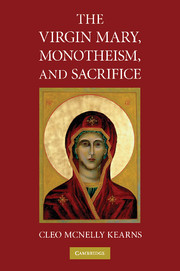Book contents
- Frontmatter
- Contents
- Preface
- Acknowledgments
- Introduction: A Vehement Flame
- PART ONE THEORIES OF SACRIFICE
- PART TWO MARY, MOTHERHOOD, AND SACRIFICE IN THE GOSPELS
- PART THREE MARY AND PRIESTHOOD
- 7 The Order of Melchizedek: Hebrews and Revelation
- 8 Mary, Priesthood, and Paternity in the Protoevangelion and the Qur'an
- 9 Eucharist and Ecclesia: Mary as Temple of the Temple
- Conclusion: Beyond Orthodoxy
- Notes
- Index
8 - Mary, Priesthood, and Paternity in the Protoevangelion and the Qur'an
Published online by Cambridge University Press: 27 July 2009
- Frontmatter
- Contents
- Preface
- Acknowledgments
- Introduction: A Vehement Flame
- PART ONE THEORIES OF SACRIFICE
- PART TWO MARY, MOTHERHOOD, AND SACRIFICE IN THE GOSPELS
- PART THREE MARY AND PRIESTHOOD
- 7 The Order of Melchizedek: Hebrews and Revelation
- 8 Mary, Priesthood, and Paternity in the Protoevangelion and the Qur'an
- 9 Eucharist and Ecclesia: Mary as Temple of the Temple
- Conclusion: Beyond Orthodoxy
- Notes
- Index
Summary
The boundary, which they call by many names, has two functions; one that stabilizes, the other that divides. In stabilizing and establishing, it is the cross; in dividing and bounding it is the boundary.
attributed to Valentinian PtolemyJoseph, I see with my eyes two peoples, one weeping and lamenting and one rejoicing and exulting.
Mary, in the Protoevangelion of JamesIn many ways, the figure of mary both accentuates some problems with the new Christian cult and offers a number of typological solutions. On the one hand, Mary's universal motherhood, her ethereal quality, her virginal conception of her son, together with that female connection to all that is “other” and outside the normal boundaries of patriarchy she sometimes signifies, all contribute to the expansion and dissemination of the religious formation she helps to inaugurate.
On the other hand, Mary's human identity, her role as a New Abraham and Daughter of Zion, her close association with her son and his sacrifice on the cross, and her own impeccable lineage and faithful obedience prevent her from drifting too far free of the past and enable her to represent continuity as well as rupture. We have seen how closely linked she is through imagery, vision and logic, to the cultic life of Israel and its discourse of sacrifice. At the same time, she signals the revaluation of that discourse and a series of breaks with in it that will increase in intensity over time, and she signals these not only by her role as pillar of orthodoxy with respect to Christian cultic and sacrificial issues but by her gender as well.
- Type
- Chapter
- Information
- The Virgin Mary, Monotheism and Sacrifice , pp. 231 - 257Publisher: Cambridge University PressPrint publication year: 2008



